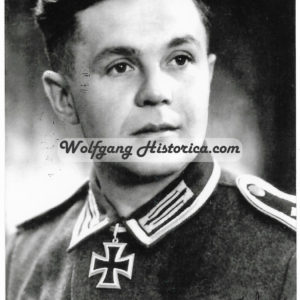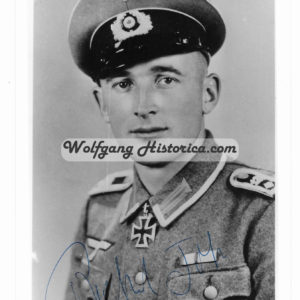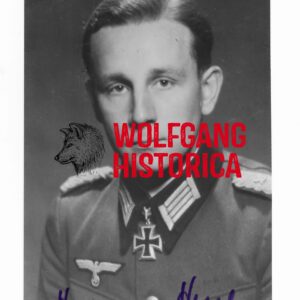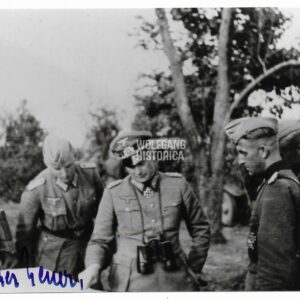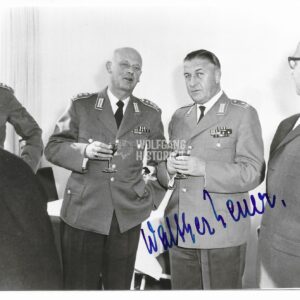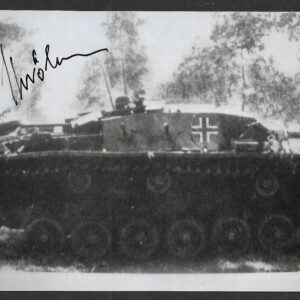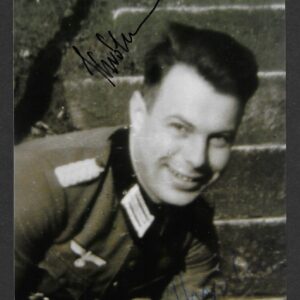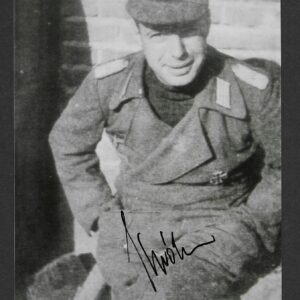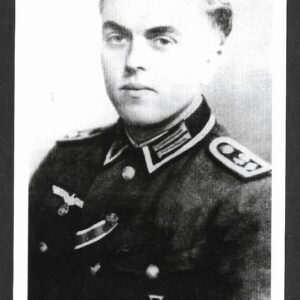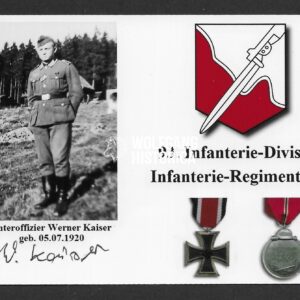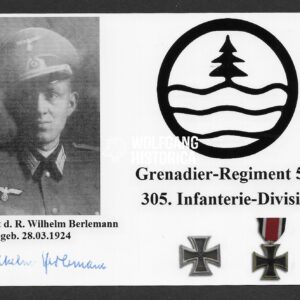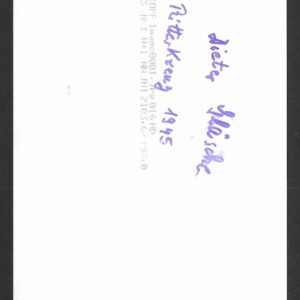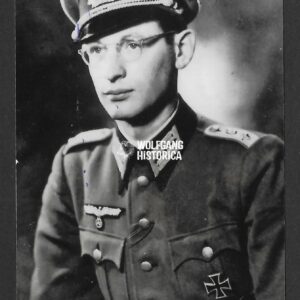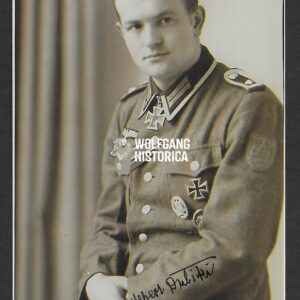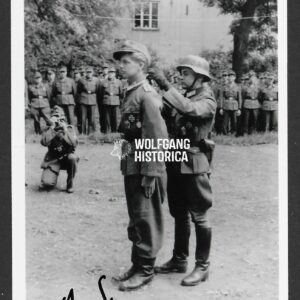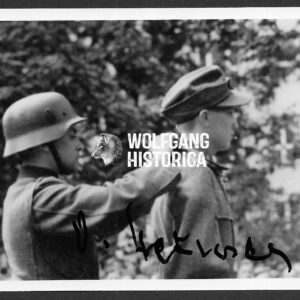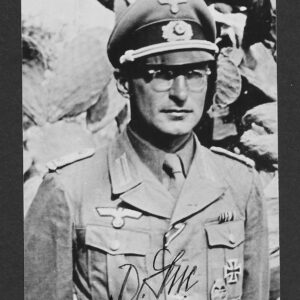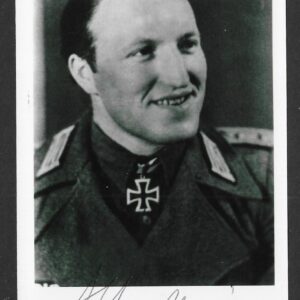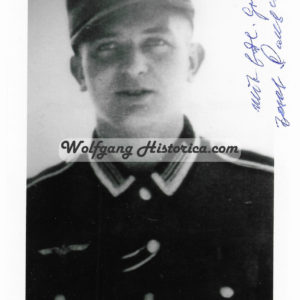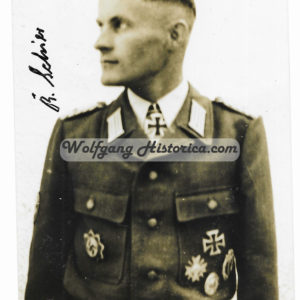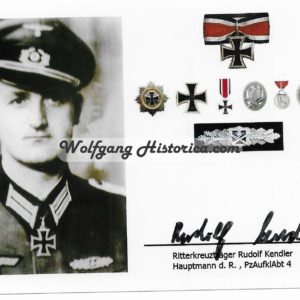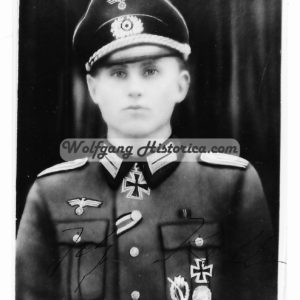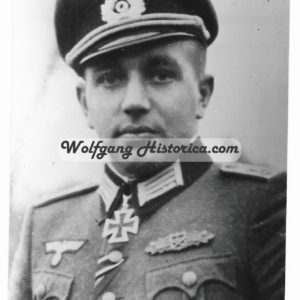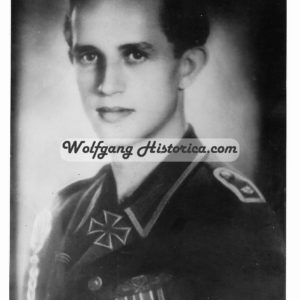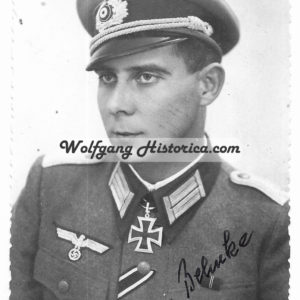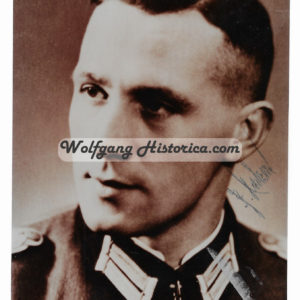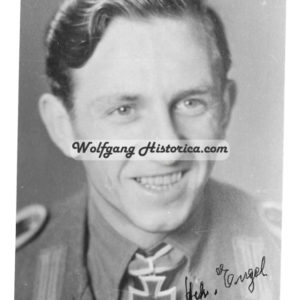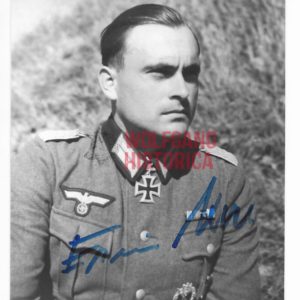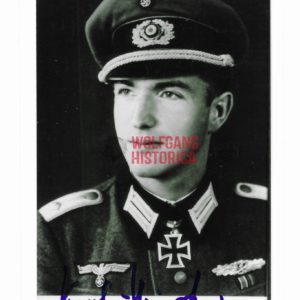Customers facing issues ordering, contact me
via info@wolfganghistorica.com or wolfganghistorica@gmail.com
Walther Sievers – Grenadier-Regiment 415 (123.Inf.Div.)
Original Postwar Signature on a Postwar Photo of Walther Sievers. Oberstleutnant Walther Sievers (15.06.1902 in Halstenbeck † 12.07.1982) earned the Ritterkreuz des Eisernen kreuzes on December 19, 1942 Hauptmann und Kommandeur of the III. Bataillon/ Infanterie-Regiment 415 and the Eichenlaub on January 29, 1944 as Oberstleutnant und Kommandeur of the Grenadier-Regiment 415 of the 123. Infanterie-Division.
Franz Ketterl – Infanterie-Regiment 438 (132. Infanterie-Division)
Original Postwar Signature on a Postwar Photo of Franz Ketterl. Oberleutnant Franz Ketterl (21.03.1898 † 27.07.1979) earned the Ritterkreuz on January 12, 1942 as Oberleutnant und Chef of the 1. Kompanie/ Infanterie-Regiment 438 of the 132. Infanterie-Division.
Provenance: This signature comes from one of the largest postwar signature collection I’ve ever commissioned. This collection was started by a Waffen-SS Veteran, Werner H., in the 1950’s until he passed away.
Günter Prill – Grenadier-Regiment 51 (18. Infanterie-Division)
Richard John – Grenadier-Regiment 445 (134.Inf.Div.)
€15,00Johann Biehl – Infanterie-Regiment 124
€15,00Unknown Knight’s Cross Holder in Bundeswehr uniform
€15,00In stock
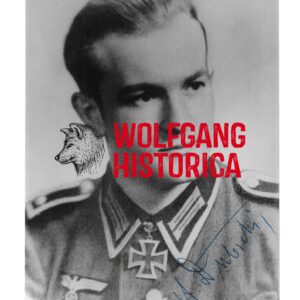
Albert Dubicki – Werfer-Regiment 14
Original Postwar Signature on a Postwar Photo of Albert Dubicki. Unteroffizier Albert Dubicki (12.07.1921 † 25.10.2009) earned the Ritterkreuz on August 12, 1944 as Unteroffizier und MG-Vorgeschobener Beobachter in the 1. Batterie/ Werfer-Regiment 14.
Provenance: This signature comes from one of the largest postwar signature collection I’ve ever commissioned. This collection was started by a Waffen-SS Veteran, Werner H., in the 1950’s until he passed away.
Friedrich Bader – Hochgebirgsjäger-Bataillon 3
€15,00Original Postwar Signature on a Card (Photo is just an addition!) of Friedrich “Fritz” Bader. Major Friedrich Bader (21.06.1908 in Forst in der Lausitz † 16.05.1997 in Bonn) earned the Deutsches Kreuz in Gold on June 9, 1943 and the Ritterkreuz des Eisernen Kreuzes on August 12, 1944 as Major und Kommandeur of the Hochgebirgsjäger-Bataillon 3.
Provenance: This signature comes from one of the largest postwar signature collection I’ve ever commissioned. This collection was started by a Waffen-SS Veteran, Werner H., in the 1950’s until he passed away.
Hermann Henle – Werfer-Regiment 70
€15,00Walther Neuer – Kampfgruppe in Ploesti
€15,00Walther Neuer – Kampfgruppe in Ploesti
€15,00Provenance: This signature comes from one of the largest postwar signature collection I’ve ever commissioned. This collection was started by a Waffen-SS Veteran, Werner H., in the 1950’s until he passed away.
Hermann Henle – Werfer-Regiment 70
€15,00Heinrich Kröhne – Sturmgeschütz-Brigade 190
€15,00Heinrich Kröhne – Sturmgeschütz-Brigade 190
€15,00Heinrich Kröhne – Sturmgeschütz-Brigade 190
€15,00Manfred Beutner – 329. Infanterie-Division
€15,00Georg Peschel – Jäger-Regiment 49 (28. Jäger-Division)
€15,00Werner Kaiser – Infanterie-Regiment 272
€15,00Wilhelm Berlemann – Grenadier-Regiment 578 (305. Infanterie-Division)
€15,00Dieter Gläsche – Panzergrenadier-Regiment 11 (9. Panzer-Division)
€15,00Albert Dubicki – Werfer-Regiment 14
€15,00August Kaminski – schwere Panzerjäger-Abteilung 655
€15,00Othmar Hermes – Grenadier-Regiment 464 (253. Infanterie-Division)
€15,00Othmar Hermes – Grenadier-Regiment 464 (253. Infanterie-Division)
€15,00Alfred Sekund – Artillerie-Regiment 11
€15,00Alfred Sekund – Artillerie-Regiment 11
€15,00Heinrich Timpe – Heeres-Sturmgeschütz-Brigade 300
€15,00Otto Hamburger – Grenadier-Regiment 426 (126. Infanterie-Division)
€15,00Dr. Heinz Lotze – Panzer-Grenadier-Regiment “Kahle”
€15,00Erich Eichler – Artillerie-Regiment 20 (20. Panzer-Grenadier-Division)
€17,50Provenance: This signature comes from one of the largest postwar signature collection I’ve ever commissioned. This collection was started by a Waffen-SS Veteran, Werner H., in the 1950’s until he passed away.
Heinrich Angelmaier – Sturmgeschütz-Brigade 279
€17,50Robert Alber – Panzer-Regiment 201
€18,00Horst Naumann – Sturmgeschütz-Abteilung 184
€18,00Original Postwar Signature on a Postwar Photo of Horst Naumann. Unteroffizier Horst Naumann (23.12.1921 in Berlin † 27.11.2000 in Großhansdorf) earned the Ritterkreuz des Eisernen Kreuzes on January 4, 1943 as Unteroffizier und Geschützführer in the 3. Batterie/ Sturmgeschütz-Abteilung 184.
Provenance: This signature comes from one of the largest postwar signature collection I’ve ever commissioned. This collection was started by a Waffen-SS Veteran, Werner H., in the 1950’s until he passed away.Johann Pongratz – Infanterie-Regiment 74
€20,00Klaus Ritter – Grenadier-Regiment 67 (23. Inf.-Div.)
€20,00Rudolf Schier – Jäger-Regiment 49
€20,00Rudolf Kendler – Panzer-Aufklärungs-Abteilung 4
€20,00Heinz-Georg Ritter – Grenadier-Regiment 44
€20,00Johannes Koll – Grenadier-Regiment 696 (340. Inf.-Div.)
€20,00Ludwig Lang – Artillerie-Regiment 7
€20,00Hans Fiedler – Grenadier-Regiment 309
€20,00- Original Postwar Signature on a Postwar Photocopy of Hans Fiedler. Oberfeldwebel Hans Fiedler (01.12.1919 † 06.07.1997) earned the Ritterkreuz on February 18, 1945 as Oberfeldwebel und Kompanie-Truppführer in the 9. Kompanie/ Grenadier-Regiment 309 of the 208. Infanterie-Division. Good condition. Postcardsize.
Heinz Behnke – Grenadier-Regiment 668
€20,00Albert Langer – Grenadier-Regiment 51
€20,00Aloys Mocken – Grenadier-Regiment 216 (86. Inf.-Div.)
€20,00Karl-Heinz Knollmann – Grenadier-Regiment 45
€20,00Heinrich Engel – Sturmgeschütz-Abteilung 259
€20,00Erwin Koch – Grenadier-Regiment 447
€20,00Karl-Heinz Becker – Jäger-Regiment 228
€20,00“On the 20.03.1944 the Führer and Supreme Commander of the Wehrmacht awarded the Knight’s Cross of the Iron Cross to Leutnant d.R. Karl-Heinz Becker, commander of 2./Jäger-Regiment 228, as the 16th soldier of the Division to be so honoured. Leutnant Becker, Kompanie commander of 2./Jäger-Regiment 228, has repeatedly distinguished himself through his flexible leadership and exemplary devotion to duty. On the 24.01.1944 he would distinguish himself through extraordinary bravery as both a leader and fighter.
On this day Leutnant Becker and his Kompanie took part in Jäger-Regiment 228’s attack against Konjuschewka. As he and his men were approaching the village’s southwestern edge he identified a primary resistance nest around a haystack at the village edge. Acting swiftly, he drove his Kompanie forward in short, swift bounds and broke into the enemy strongpoint. In the bitter struggle which followed he and his Kompanie smashed this cornerstone of the enemy defense. In the process 3 anti-tank guns and 2 heavy machine-guns were knocked out, and the garrison itself was wiped out in melee combat. After eliminating this resistance nest, he and his Kompanie thrust through the village from south to north. In doing so they smashed the entire enemy defensive position along the western edge of Konjuschewka. In this latter stage of the battle another 3 anti-tank guns and several MGs were put out of action. At this stage Leutnant Becker received the mission of penetrating deeper into the village and reaching its opposite edge. Here he would hold his position and wait for further orders in order to allow the follow-up Bataillon to conduct an orderly regrouping within Konjuschewka. Following hard street and house combat, in which Becker personally eliminated several resistance nests with his machine-pistol, he reached the ordered objective. However strong enemy forces continued to hold out in the northern part of Konjuschewka. From here they plastered heavy fire onto both the following elements of I. Bataillon and II. Bataillon, forcing them to periodically take cover.
The enemy’s firepower suddenly received a substantial boost in the form of an additional enemy battery. Consisting of 3 artillery pieces (12.2 cm calibre), it fired into our Kompanien from a point about 1 km east of Konjuschewka. The enemy, who had hitherto only been able desperately defend in the northern part of the village, now found new courage from this artillery fire and even launched an energetic counterthrust. A threatening crisis for the Bataillon now began to emerge. The enemy started to regain ground.
At this point Leutnant Becker made a bold decision: he would go against his orders to hold the village edge. Instead, undeterred by the heavy and direct artillery fire, he would swiftly gather up the two nearest squads of his Kompanie and charge straight towards the enemy’s battery position. Personally intervening in the resultant close combat in a decisive manner, he and his men engaged the gun crews, killing some and forcing the remainder to flee. As a result the battery was eliminated, and with it the last buttress for the hostile resistance in Konjeschewka. The backbone of the enemy’s defense was broken, and the remaining elements of the Bataillon proceeded to capture the entire village within a short time. II. Bataillon was then able to prosecute its own attack unhindered.”





